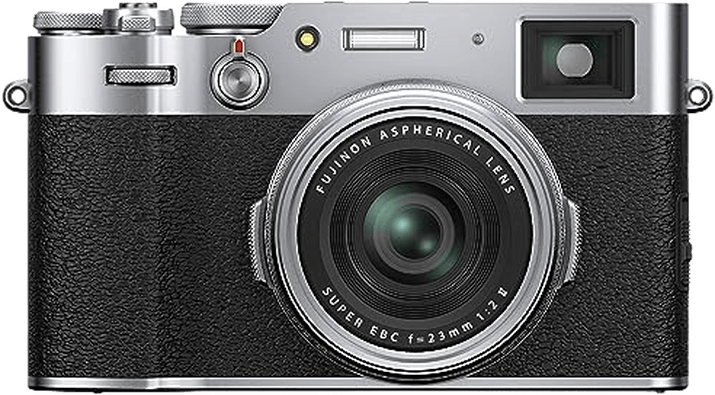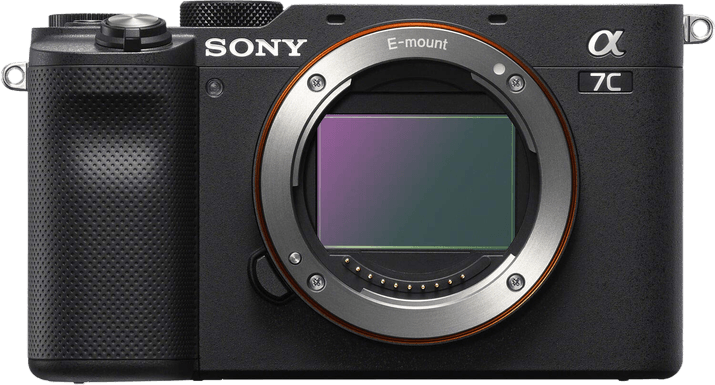Fujifilm X100V vs Sony a7C Comparison
Fujifilm X100V

Sony a7C

The Sony a7C outperforms the Fujifilm X100V with a score of 78/100 compared to 69/100. Both mirrorless cameras were released in 2020, with the Fujifilm X100V priced at $1,399 and the Sony a7C at $1,799. They share a similar size, with the Fujifilm X100V measuring 128 x 75 x 53mm and the Sony a7C at 124 x 71 x 60mm. The Sony a7C is slightly heavier at 509g, while the Fujifilm X100V weighs 478g.
The higher score of the Sony a7C reflects its superior performance. It offers better image quality, autofocus, and video capabilities than the Fujifilm X100V. However, the Fujifilm X100V has a lower price and lighter weight, making it a more budget-friendly and portable option for some users.
Taking these factors into account, the Sony a7C is the clear winner for those seeking top-notch performance and features, while the Fujifilm X100V remains a solid choice for those prioritizing affordability and portability.
Fujifilm X100V vs Sony a7C Overview and Optics
The Sony a7C outperforms the Fujifilm X100V in optics with a score of 80/100 versus 66/100. Both cameras share common specifications, including a CMOS sensor, similar megapixels (24.2 for Sony a7C and 26 for Fujifilm X100V), and comparable shooting speeds (10 fps for Sony a7C and 11 fps for Fujifilm X100V). However, the Sony a7C excels in several areas, making it the superior option in terms of optics.
The Sony a7C boasts a full-frame sensor, which provides better image quality and low-light performance than the Fujifilm X100V’s APS-C sensor. Additionally, the Sony a7C has a DXOMARK sensor score of 95, reflecting its high-quality sensor performance. The Fujifilm X100V does not have a DXOMARK score as the platform does not score Fujifilm cameras.
Another advantage of the Sony a7C is its interchangeable lens mount (Sony FE), allowing users to swap lenses for various shooting situations. In contrast, the Fujifilm X100V has a fixed lens mount, limiting its versatility. Moreover, the Sony a7C features image stabilization, reducing the chances of blurred images due to camera shake, whereas the Fujifilm X100V lacks this feature.
The Fujifilm X100V, however, offers a slightly faster shooting speed and higher megapixel count, which may be beneficial for specific photography styles. Yet, these advantages do not outweigh the superior optics of the Sony a7C.
Considering the differences in sensor size, lens mount flexibility, and image stabilization, the Sony a7C emerges as the clear winner in terms of optics. The Fujifilm X100V may have minor advantages in shooting speed and megapixel count, but these factors do not compensate for its limitations when compared to the Sony a7C.
Fujifilm X100V vs Sony a7C Video Performance
The Fujifilm X100V emerges as the winner in video capabilities with a score of 91/100, while the Sony a7C scores 70/100. Both cameras share certain specifications, such as 4K maximum video resolution and built-in time-lapse functionality. However, the Fujifilm X100V outperforms the Sony a7C in several aspects.
The X100V has a higher maximum video dimension of 4096 x 2160 compared to the a7C’s 3840 x 2160. This difference results in a larger and more detailed video output. Additionally, the X100V offers a maximum video frame rate of 120fps, which is significantly higher than the a7C’s 30fps. This higher frame rate allows for smoother video playback and better slow-motion capabilities.
On the other hand, the Sony a7C has some advantages, although they are not as significant as those of the X100V. The a7C’s 4K video resolution and built-in time-lapse functionality are still noteworthy features, but they do not make up for the lower maximum video dimensions and frame rate.
In comparing the video capabilities of the Fujifilm X100V and the Sony a7C, it is clear that the X100V is the superior camera for videographers. Its higher maximum video dimensions and frame rate provide better video quality and performance. While the Sony a7C does have some positive aspects, they are not enough to compete with the X100V’s more advanced video features.
Fujifilm X100V vs Sony a7C Features and Benefits
The Fujifilm X100V outperforms the Sony a7C with a feature score of 85/100 compared to 81/100. Both cameras share common specs, including a 3-inch screen size, touchscreen capability, flip screen, GPS absence, and WIFI and Bluetooth connectivity.
The X100V excels with a higher screen resolution of 1,620,000 dots, providing sharper and clearer images for photographers. This advantage allows users to preview their shots with more precision, ensuring the final output meets their expectations.
On the other hand, the Sony a7C is not entirely outclassed by the X100V. Both cameras offer modern features that cater to the needs of photographers today. The a7C matches the X100V in terms of screen size, touchscreen, flip screen, and connectivity options. However, it falls short in screen resolution, offering only 921,600 dots, which may affect the user’s experience when reviewing images on the camera.
In comparing the Fujifilm X100V and Sony a7C, the X100V takes the lead with its higher feature score and superior screen resolution. This advantage allows photographers to review their shots with greater accuracy and detail. While the Sony a7C offers similar features, its lower screen resolution may impact the user experience. Ultimately, the choice between these two cameras will depend on individual preferences and priorities, but the Fujifilm X100V stands out as the better option based on its features.
Fujifilm X100V vs Sony a7C Storage and Battery
The Sony a7C outperforms the Fujifilm X100V in storage and battery, scoring 45/100 compared to the X100V’s 37/100. Both cameras have one memory card slot, and both accept SD, SDHC, and SDXC cards. Additionally, both cameras offer USB charging.
The a7C’s superior storage and battery performance stems from its compatibility with UHS-II cards and longer battery life. With a battery life of 740 shots, the a7C provides significantly more shooting time than the X100V, which only offers 420 shots. The Sony a7C also uses the NP-FZ100 battery type, contributing to its extended battery life.
Despite its lower score, the Fujifilm X100V still performs well in this category. It accepts UHS-I compatible memory cards and uses the NP-W126S battery type. Although its battery life is shorter than the a7C’s, 420 shots remain a respectable amount for most photography needs.
Considering these factors, the Sony a7C offers better storage and battery performance, making it the preferable choice for photographers who prioritize longer shooting times and faster memory card compatibility. However, the Fujifilm X100V remains a viable option for those who do not require extensive battery life or the fastest memory card support.
Fujifilm X100V vs Sony a7C – Our Verdict
Are you still undecided about which camera is right for you? Have a look at these popular comparisons that feature the Fujifilm X100V or the Sony a7C:

